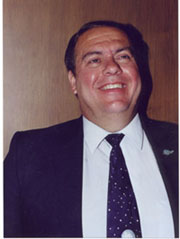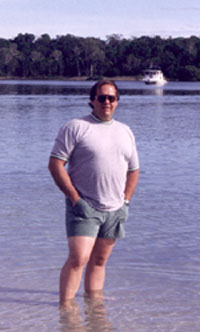|
(Founder and Director, Southwest Institute for Space Research) |
|||||||||||||||
| Alan Hale was born in Tachikawa, Japan, in 1958 but moved with his family later that year to Alamogordo, New Mexico, where he spent the remainder of his childhood years. After graduation from Alamogordo High School in 1976 he attended the U.S. Naval Academy in Annapolis, Maryland, where he graduated with a Bachelor's Degree in Physics in 1980. | |||||||||||||||
 |
|||||||||||||||
| After assignments at duty stations in San Diego and Long Beach, California, he left the Navy in 1983 and began working at the Jet Propulsion Laboratory in Pasadena, California, as an engineering contractor for the Deep Space Network. While at JPL he was involved with several spacecraft projects, most notably the Voyager 2 encounter with the planet Uranus in 1986.
Following the Uranus encounter Alan Hale left JPL and returned to New Mexico, enrolling in the Astronomy department at New Mexico State University in Las Cruces. He earned his Master's Degree in 1989 and his Ph.D. in 1992 with a thesis entitled "Orbital Coplanarity in Solar-Type Binary Systems: Implications for Planetary System Formation and Detection" (which was published in the January 1994 issue of the Astronomical Journal). Upon earning his doctorate he initially worked at The Space Center (now the New Mexico Museum of Space History) in Alamogordo, New Mexico as its Staff Astronomer and Outreach Education Coordinator, and in 1993 he founded the Southwest Institute for Space Research. |
|||||||||||||||
| Alan Hale's research interests include the search for planets beyond the solar system, including those which might have favorable environments for life; stars like the sun; minor bodies in the solar system, especially comets and near-Earth asteroids; and advocacy of spaceflight. He is primarily known for his work with comets, which has included his discovery of Comet Hale-Bopp in 1995 and his participation in the International HalleyWatch during the return of Halley's Comet in 1986. In one of his more recent projects he has led two delegations of American scientists, students, and educators to Iran to engage in person-to-person science diplomacy with the Iranian people, the first to collect observations of the August 11, 1999 total solar eclipse and the second in July 2000 to participate in an international astronomical conference in Esfahan.
Besides his research activities, he is an outspoken advocate for improved scientific literacy in our society, for better career opportunities for current and future scientists, and for taking individual responsibility to make ours a better society. He has written for such publications as Astronomy, the International Comet Quarterly, the Skeptical Inquirer, Free Inquiry, and the McGraw-Hill Yearbook of Science and Technology, and he writes a weekly newspaper column entitled "In Our Skies" (which has recently been compiled into an e-book available on CD). He is the author of Everybody's Comet: A Layman's Guide to Comet Hale-Bopp (High-Lonesome Books, 1996), is a frequent public speaker on astronomy, space, and other scientific issues and, beginning in May 2004, is host of a weekly radio program, "The Other Side of the Sky." While continuing to remain active in his other activities, at the present time Alan Hale is developing the Earthrise Project, an international goodwill and educational endeavor that he conceived in early 2002, and that builds upon his previous efforts in science diplomacy. |
|||||||||||||||
| Alan Hale lives in the Sacramento Mountains outside of Cloudcroft, New Mexico, with his wife Eva, sons Zachary and Tyler, dog Percy, and several cats. On clear nights he can often be found making observations of the latest comets or other astronomical phenomena. When he is not engaged in his astronomical activities he enjoys running up and down the mountain roads, hiking in the hills, listening to the latest rock 'n roll music, and watching football games. |  |
||||||||||||||
| Order an autographed poster of this photograph. | |||||||||||||||
| BACK TO MAIN PAGE | |||||||||||||||